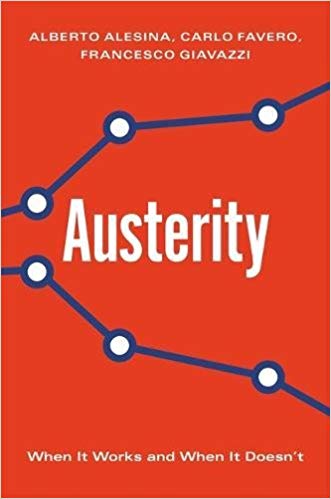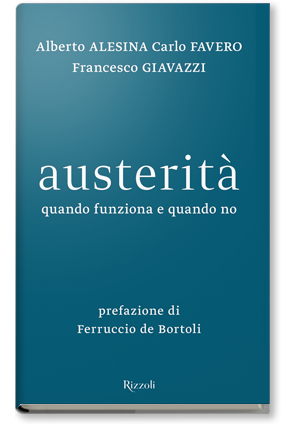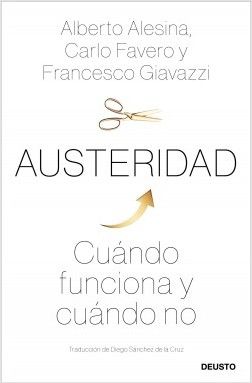- Teaching
- Working papers
- Publications
- Research Interests
- Education is not about filling buckets but lighting fires
- Austerity. When it Works and When it doesn't
- Applied Macroeconometrics
- Lectures on the Theory and Application of Modern Finance with R and ChatGPT
- PhD supervision
- The Pelicans (Bocconi Sport Team)
- CV
- Contact me
Austerity. When it Works and When it doesn't
 |
 |
 |
 |
The debate surrounding the macroeconomic effects of deficit reduction policies (austerity) has focused on their effects on growth, and tones have become very loud on the plausibility of "expansionary" austerity. This discussion has distracted commentators and policymakers from the most policy relevant result, namely he enormous difference, on average, between expenditure based and tax based austerity plans. Spending based austerity plans are remarkably less costly than tax based plans. The former have on average a close to zero effect on output and lead to a reduction of the debt over GDP ratio. Tax based plans have the opposite effect and cause large and long lasting recessions.
The Dataset constructed for the book, together with a sample chapter describing the empirical models estimated and simulated, is described and made available for download at
http://www.igier.unibocconi.it/fiscalplans
Austerity in eight questions (and answers)
(1) What is controversial about fiscal austerity?
The term austerity indicates a policy of sizeable reduction of government deficits and stabilization of government debt achieved by means of spending cuts or tax increases. Discussions about the relative benefits and costs of the austerity policies have been toxic, often taking a very ideological, harsh, tone. The anti-austerity front argues that austerity is counterproductive: it results in increases, rather than reductions, in the debt-over-GDP ratio since it generates reductions in the denominator of this ratio which more than offset the gains in the numerator. The pro-austerity front emphasizes the impact of expectations and confidence on government debt. Imagine a situation in which an economy is on an unsustainable path with an exploding public debt. Sooner or later a fiscal stabilization has to occur. The longer this is postponed, the higher the taxes that will need to be raised or the spending to be cut in the future. When the stabilization occurs it removes the uncertainty about further delays which would have increased even more the costs of the stabilization.
(2) Why did you write this book?
The harsh discussion on the effects of austerity has distracted commentators and policymakers from the most policy relevant result, namely the enormous difference, on average, between expenditure based and tax based austerity plans. This book discusses the theory and the evidence needed to more properly assess the consequences of the different types of austerity.
(3) What are some examples of different types of austerity?
Spending based austerity plans are remarkably less costly than tax based plans. The former have on average a close to zero effect on output and lead to a reduction of the debt over GDP ratio. Tax based plans have the opposite effect: they cause large and long lasting recessions and do not lead to the stabilization of the debt to GDP ratio. Two recent examples are the consolidations carried out by Ireland and Spain in response to the Eurozone crisis. The Spanish correction, which featured a larger share of tax hikes, markedly slowed the real GDP growth and did not result in a decline in the debt ratio. In Ireland instead, the spending-based correction had little output costs and led to a sharp decline in debt.
(4) How should we change our thinking about austerity in order to assess its effectiveness properly?
The empirical analysis of the macroeconomic effect of different types of austerity is crucial. To this end one should start from the data. We have documented in detail close to 200 austerity plans carried out in 16 OECD economies from the late 1970s to 2014. To reconstruct these plans we have consulted original documents (some produced by national authorities, some produced by organizations such as the OECD, the IMF or the European Commission) concerning about 3,500 individual fiscal measures. The second step is the proper modelling of fiscal actions. When legislatures decide to launch a fiscal consolidation program, this rarely consists of isolated shifts in this or that tax, or in this or that spending item; instead, what is adopted is typically a multi-year plan with the objective of reducing the budget deficit by a certain amount every year. To the extent that expectations matter for the planning of consumers and investors, the multi-year nature of a fiscal adjustment, and the announcements that come with it, matter for their economic effects. Third, the effect of different plans on the economy should be assessed. We document a sharp difference between adjustment plans based mostly on tax increases and plans based mostly on expenditure reductions. This finding suggests that there is no "austerity" as such: the effects of austerity policies are sharply different depending on the way they are implemented.
In assessing the empirical evidence we needed to overcome three major obstacles.
The first is the so-called “ endogeneity” problem, namely the interaction between fiscal policy and output growth. Suppose you observe a reduction in the government deficit and an economic boom. It would be highly questionable to conclude that policies that reduced deficits have generated growth, as it could easily be the other way around. We address the endogeneity problem by considering only policy changes not motivated by the state of the business cycle but rather by a desire to reduce deficits.
Second, once exogenous fiscal adjustments episodes have been identified, then the calculation of their impact on the economy requires the specification of an empirical model. An important tradeoff emerges here: the simpler the model the easier to calculate the multipliers, but the simpler the model the more likely is that important relations among variables are missed. We adopt several models in this book to assess the robustness of our empirical results.
Third, major episodes of austerity often are accompanied by changes in other policies: monetary policy; exchange rate movements; labor market reforms; regulation or deregulation of various product markets; tax reforms; and so on. In addition, austerity is sometimes adopted at times of crisis due to runaway debts, not in periods of business as usual. We assess explicitly the role of accompanying policies in the determination of the impact of austerity to conclude that the heterogenous effects of TB and EB plans does not depend on different accompanying policies.
(5) In cases where austerity has “gone wrong” what accounted for that? What should have been done differently?
During 2010-11 the collapse of confidence in sovereign European debt and the explosion of interest rates on government bonds in some countries (Italy, Spain, Greece, Portugal) led to a situation that was close to a debt-induced financial crisis. Could have the governments of these countries waited, postponing austerity to when the recession was over? Hard to say. We do not know what would have happened absent austerity. What we can say, however, is that even in these cases, namely when austerity policies are implemented during a recession, the differences between the two types of austerity is very relevant: tax-based austerity plans have been much more costly than spending-based plans
(6) What are the circumstances under which politicians can “survive” the implementation of austerity measures?
Contrary to common beliefs, the data do not show that politicians who implement austerity policies systematically lose the next elections. Presumably when the need for austerity is well explained to the voters, and austerity is not too costly in terms of short run output losses, they can be successful.
(7) Can you give an example of a politician who had the right idea about austerity?
In the 1990s Canada implemented a successful package of large government cuts which, coupled with accommodating monetary policy and structural reforms, was expansionary. In the book we document how since the 1993 elections almost all the contending parties accepted the need for such a reduction in government debt and deficit. In 2010, the Coalition government led by David Cameron in the UK responded to unsustainable and growing deficits with a program of large budget cuts. After this correction, the UK economy grew at respectable rates compared to the other major economies and proved the IMF predictions of a major recession wrong. Finally, and maybe most interestingly, the Irish government in its December 2009 Stability Programme Update was clear in acknowledging the unsuccessful effects of tax-based austerity. This in turn justified the adoption of a package of significant expenditure cuts.
(8) What do you hope readers will take away from this book?
Talking about “austerity” without distinction of how austerity is implemented does not make any sense. The composition of austerity plans is crucial to understand their effects on growth and fiscal sustainability. The data on 16 OECD countries over the period 1978-2014 show that a spending reduction plan and tax hikes plans of the same dimension have different effects on growth. Tax based plans lead to deep and prolonged recessions, lasting several years. Expenditure based plans on average exhaust their very mild recessionary effect within two years after a plan is introduced. The component of aggregate demand which mostly drives the heterogeneity between tax-based and expenditure-based austerity is private investment. The effects of fiscal plans on the debt to GDP ratio depend on the initial level of the debt. In the high-debt high-cost of debt scenario an expenditure based plan has a stabilizing effect on the debt dynamics while a tax based plan has a destabilizing effect; in a low-debt low-cost scenario the expenditure based adjustment remains stabilizing, while the effect of a tax based plan becomes neutral. The main goal of our work is to explain the empirics and the theory which underlie these results. To this end we discuss the theory, we construct a new data set, we propose to analyze fiscal plans to take the empirical modelling of fiscal policy closer to the real-life process of its implementation, we consider case-studies and econometric evidence. We also study the role of accompanying policies: devaluations, monetary policy and structural reforms in the goods and labor markets. We devote special attention to the recent round of austerity plans implemented after the financial and Eurozone crises. Finally, we ask the political economy question of whether austerity is the kiss of death for the governments that implement it, concluding that the answer is much less obvious than the popular debate would seem to suggest.